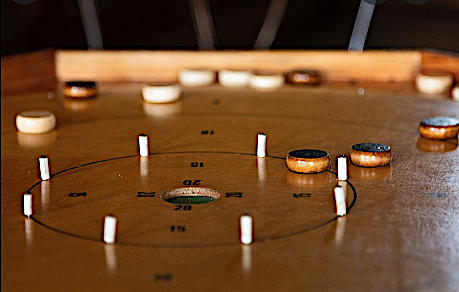One of Saugeen Times’ favourite columnists, Rev. Bob Johnston has returned for a ‘guest spot’, the first of which we hope will lead to many more as his down-to-earth writings and wit have struck a chord with our readers over the years.
———————————————
 My middle finger had a real workout over this recent Victoria Day long weekend. I hasten to clarify that I was not angrily saluting speeding drivers or too-noisy motorcycles. I was playing crokinole with my two visiting grandsons. They insisted on game after game in hopes of finally beating me. In fact, we played so many tournaments that by Tuesday morning, my middle finger was stiff and aching.
My middle finger had a real workout over this recent Victoria Day long weekend. I hasten to clarify that I was not angrily saluting speeding drivers or too-noisy motorcycles. I was playing crokinole with my two visiting grandsons. They insisted on game after game in hopes of finally beating me. In fact, we played so many tournaments that by Tuesday morning, my middle finger was stiff and aching.
For readers unfamiliar with the connection between crokinole and my sore finger, I will offer enlightenment. The authoritative website CrokinoleCanada describes this recreational activity as “a disc-flicking dexterity board game.” According to Wikipedia, the name “crokinole” is assumed to be derived from the French word “ croquignole,” a round biscuit or cookie. A subsequent derivation of the word “fillip,” is translated as ”a flicking of the finger.” Evidently, to protect my status as Johnston household champion, I may have over-flicked.

Along with lacrosse and ice hockey, crokinole claims a Canadian origin. The oldest surviving board was crafted by Eckhardt Wettlauffer, a farmer and craftsman, whose German immigrant family settled in Perth County near Tavistock (Ontario). According to several historical and family sources, Wettlauffer carved the board in 1876 as a birthday present for his five-year-old son, Adam. It can still be found on display at the Joseph Schneider Haus Museum in Kitchener.
Crokinole is played on a round or octagonal highly-polished wooden board. Its playing surface is 26 inches in diameter with a hole in the centre of four concentric marked circles. The object of the two-person game is for each player to shoot their 12 discs in turn, trying to place them in the hole if the board is clear. Otherwise, the player must attempt to flick the opponent’s discs off the board. If the shooter misses their opponent’s disc, it is removed from play. At game’s end, each disc that reached the hole counts for 20 points while other pieces remaining on the board score 5,10 or 15, depending on which concentric circle they are sitting in.
It seems like we have always had a board in our various homes. My current one was handcrafted by a friend and fellow-crokinole player. Wray and I habitually set up the table whenever we would visit. After several years, we felt skilled enough to enter the local Senior Games for its crokinole doubles competition. We soon discovered that the word “skill” is a relative term. A two-person team from Hanover quickly knocked us out in the first round. While Wray and I celebrated every rare 20-shot as a minor miracle, our opponents sunk them routinely.
Scheduled for June 4, Tavistock had to cancel its annual World Championship this year due to lingering concerns over the pandemic. The town has sponsored this tournament since 1991, drawing up to 400 players, including some international competitors. Interested readers can learn more about the Tournament, including official rules of crokinole and some photos of past competition by googling crokinole world championship. An informative article by Greg Colgan in the Woodstock Sentinel-Times (Crokinole Champinship Returns to Tavistock, May 29, 2019) includes fascinating video clips of highly-skilled players in competitive action.
I often gently explain to “outsiders” that the game is not pronounced “crokino,” but “crokinole.” I correct beginners who wrongly shoot by positioning their finger away from the disc then snapping, rather than snuggling tightly against it and pushing. Yet, even as a long-time player. I am still discovering more about the official rules governing this Canadian pastime. For example:
NO ROTATING: A player must not rotate the board to make a better shot. Grandkids: take note!!
ONE CHEEK ONLY: Similarly, a player must remain in his/her chair to make a shot. More precisely: while leaning is allowed for a better angle, one butt cheek must remain firmly on the seat of the chair.
NO HIDING: A player must place their discs within the 15-circle when no opponent’s pieces are on the board. Over the weekend, I often slid my disc behind one of the 8 pegs guarding the 15-circle, so a grandson could not get a clear shot at it. Sorry kids!!
CHOOSE A FINGER: The video showed me that many competitive players use their pointy finger to shoot, not that notorious, afore-mentioned other digit.
Crokinole has long been a favourite in many Canadian homes. In rural conservative Western Ontario, the game was historically popular among families who believed card-playing and dancing to be too worldly. While times have changed, it was still refreshing on a cold, rainy day, to see my grandsons putting down their iPhones and iPads to enjoy a cottage pastime which didn’t require devices, batteries, plug-ins or self-isolation.
PS: Yes, my older grandson finally beat me. But I will soon resume serious training, preparing for that inevitable rematch — just as soon as my middle finger stops throbbing.






